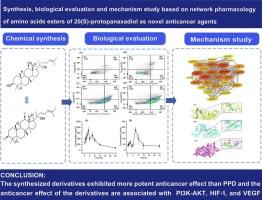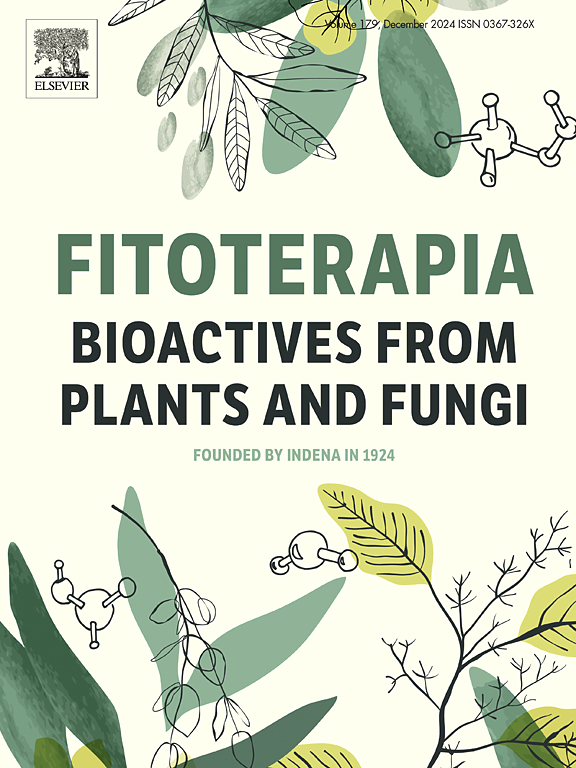Synthesis, biological evaluation and mechanism study based on network pharmacology of amino acids esters of 20(S)-protopanaxadiol as novel anticancer agents
IF 2.5
3区 医学
Q3 CHEMISTRY, MEDICINAL
引用次数: 0
Abstract
As one of the metabolites of ginseng, 20(S)-protopanaxadiol (PPD) is a compound with dammarane-type tetracyclic triterpene, which performs a wide range of anticancer activities. In this study, PPD was used as a lead. A series of compounds were synthesized respectively with 11 amino acids through esterification and were evaluated for their cytotoxicity against several cancer cell lines. One of the synthetic products (PL) exhibited potent inhibitory effect on Huh-7 cells relative to that of PPD in vitro. Subsequently, the Annexin V-FITC /PI staining assay was used to verify that PL induced apoptosis of Huh-7 cells in a dose-dependent manner. A UPLC-Q/TOF-MS analysis method was established and validated for assessing pharmacokinetic properties after the administration of PPD and PL in rats. The results showed that compared with PPD, T1/2of PL in rats was prolonged, and the peak time was delayed, resulting in broader tissue distribution of the compound in the body. In addition, the targets of PL against several cancers were predicted and analyzed via network pharmacology. Molecular docking simulations demonstrated that PL interacted with the active sites of the above targets. In conclusion, this study provided a theoretical basis for the development and clinical application of anti-tumor activity of PPD.

基于网络药理学的 20(S)-protopanaxadiol 氨基酸酯类新型抗癌剂的合成、生物学评价和机理研究。
作为人参的代谢产物之一,20(S)-原人参二醇(PPD)是一种具有达玛烷型四环三萜的化合物,具有广泛的抗癌活性。本研究以 PPD 为先导。通过酯化反应,分别与 11 个氨基酸合成了一系列化合物,并评估了它们对几种癌细胞株的细胞毒性。与 PPD 相比,其中一种合成产物(PL)在体外对 Huh-7 细胞有很强的抑制作用。随后,利用Annexin V-FITC /PI染色法验证了PL诱导Huh-7细胞凋亡的作用呈剂量依赖性。建立并验证了 UPLC-Q/TOF-MS 分析方法,用于评估大鼠服用 PPD 和 PL 后的药代动力学特性。结果表明,与PPD相比,PL在大鼠体内的T1/2延长,达峰时间延迟,从而使该化合物在体内的组织分布更广。此外,还通过网络药理学预测和分析了PL对几种癌症的作用靶点。分子对接模拟表明,PL 与上述靶点的活性位点相互作用。总之,这项研究为 PPD 抗肿瘤活性的开发和临床应用提供了理论依据。
本文章由计算机程序翻译,如有差异,请以英文原文为准。
求助全文
约1分钟内获得全文
求助全文
来源期刊

Fitoterapia
医学-药学
CiteScore
5.80
自引率
2.90%
发文量
198
审稿时长
1.5 months
期刊介绍:
Fitoterapia is a Journal dedicated to medicinal plants and to bioactive natural products of plant origin. It publishes original contributions in seven major areas:
1. Characterization of active ingredients of medicinal plants
2. Development of standardization method for bioactive plant extracts and natural products
3. Identification of bioactivity in plant extracts
4. Identification of targets and mechanism of activity of plant extracts
5. Production and genomic characterization of medicinal plants biomass
6. Chemistry and biochemistry of bioactive natural products of plant origin
7. Critical reviews of the historical, clinical and legal status of medicinal plants, and accounts on topical issues.
 求助内容:
求助内容: 应助结果提醒方式:
应助结果提醒方式:


